|
|
|
| Home > Artist Gallery > Vincent Van Gogh Art
Gallery |
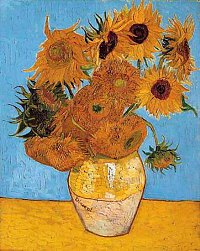
   |
|
Vase
with Twelve Sunflowers
1889
oil on canvas
The original painting is
displayed at the
Philadelphia Museum of Art, Philadelphia
Rent

|
|
Cod. Art. 001
Dim. 60x90 cm
Available
now:
Buy |
|
|
|
|
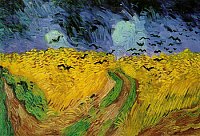
   |
|
Wheatfield
with Crows
1890
oil on canvas
The original painting is
displayed at the
Van Gogh Museum, Amsterdam
Rent

|
|
Cod. Art. 002
Dim. 60x90 cm
Available
now:
Buy |
|
|
|
|
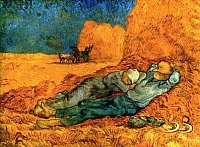
   |
|
Noon:
Rest from Work
1889-90
oil on canvas
The original painting is
displayed at the
Musee d'Orsay, Paris
Rent

|
|
Cod. Art. 022
Dim. 60x90 cm
Available
now:
Buy |
|
|
|
|
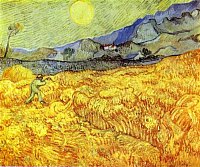
   |
|
Wheat
Field with Reaper at Sunrise
1889
oil on canvas
The original painting is
displayed at the
Van Gogh Museum, Amsterdam
Rent

|
|
Cod. Art. 027
Dim. 40,5x51 cm
Available
now:
Buy |
|
|
|
|
|
|
|
|
|
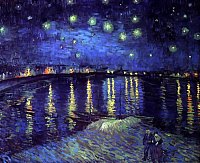
   |
|
Starry
Night Over the Rhone
1888
oil on canvas
The original painting is
displayed at the
Musee d'Orsay, Paris
Rent

|
|
Cod. Art. 034
Dim. 60x90 cm
Available
now:
Buy |
|
|
|
|
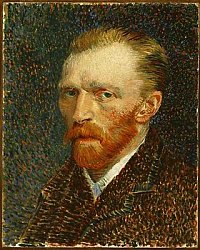
   |
|
Self-Portrait
1886-87
oil on canvas
The original painting is
displayed at the
Art Institute of Chicago
Rent

|
|
Cod. Art. 035
Dim. 40,5x51 cm
Available
now:
Buy |
|
|
|
|
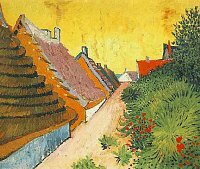
   |
|
Street in
Saintes-Maries
1888
oil on canvas
The original painting is part of
a Private Collection
Rent

|
|
Cod. Art. 038
Dim. 60x90 cm
Available
now:
Buy |
|
|
|
|
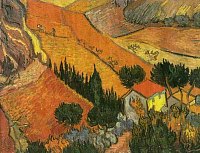
   |
|
Valley
with Ploughman Seen from Above
1877
oil on canvas
The original painting is
displayed at the
Hermitage,
St Petersburg
Rent

|
|
Cod. Art. 046
Dim. 60x90 cm
Available
now:
Buy |
|
|
|
|
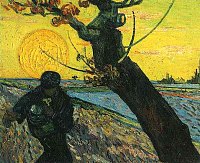
   |
|
The Sower
1888
oil on canvas
Il dipinto originale
e' esposto al
Van Gogh Museum, Amsterdam
Rent

|
|
Cod. Art. 100
Dim. 60x90 cm
Available
now:
Buy |
|
|
|
|
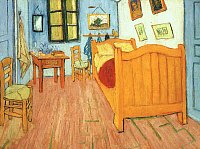
   |
|
Vincent's
Bedroom in Arles
1888
oil on canvas
The original painting is
displayed at the
Van Gogh Museum, Amsterdam
Rent

E. 29,4
monthly
(+ taxes and delivery cost) |
|
Cod. Art. 105
Dim. 60x90 cm
Available
now:
Buy |
|
|
|
|
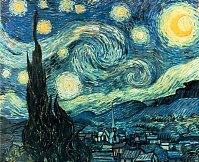
   |
|
The
Starry Night
1889
oil on canvas
The original painting is
displayed at
The Museum of Modern Art,
New York
Rent

|
|
Cod. Art. 116
Dim. 60x90 cm
Available
now:
Buy |
|
|
|
|
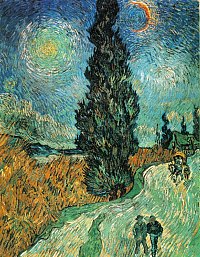
   |
|
Road with Cypress and Star
1890
oil on canvas
The original painting is
displayed at the
Kröller-Müller Museum,
Otterlo
Rent

|
|
Cod. Art. 168
Dim. 60x90 cm
Available
now:
Buy |
|
|
|
|
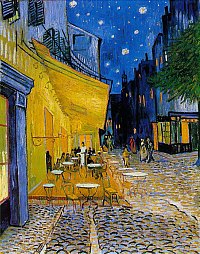
   |
|
The Cafe Terrace on the Place du Forum, Arles, at Night
1888
oil on canvas
The original painting is
displayed at the
Kröller-Müller Museum,
Otterlo
Rent

|
|
Cod. Art. 185
Dim. 60x90 cm
Available
now:
Buy |
|
|
|
|
|
|
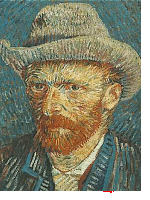 On March 30,
1853 a boy was born to the family of a Dutch village vicar, Theodorus van Gogh (1822-1885)
and his wife Anne Cornelia, nèe Carbentus (1819-1907). A year before, exactly the same
day, another boy was born to the family, he died, and now the new-born received his name:
Vincent Willem van Gogh. On March 30,
1853 a boy was born to the family of a Dutch village vicar, Theodorus van Gogh (1822-1885)
and his wife Anne Cornelia, nèe Carbentus (1819-1907). A year before, exactly the same
day, another boy was born to the family, he died, and now the new-born received his name:
Vincent Willem van Gogh.
After getting school education, van Gogh started his career as a picture salesman: in The
Hague (1869) he entered the branch office of the Paris art dealer Goupil & Cie,
founded originally by his uncle Vincent. As an agent of the company he worked in its
branches in Brussels (1873), London (1873), Paris (1875). But his personal disappointment
increased and he left Goupil.
Van Gogh tried himself as a teacher in Ramsgate near London (April-December 1876), then he
worked as an apprentice lay preacher and wanted to devote his life to evangelization of
the poor. In 1878 Vincent convinced his father of his religious vocation and in August
began a three-month course in preaching in Evangelist school in Laeken, near Brussels. At
school he was considered unsuitable for the lay-preaching profession. But he persistently
followed his inclination and went to Borinage, the Belgian coal mining area close to the
French border. There, living in extreme poverty, he visited sick people and read the Bible
to the miners.
In 1879 Vincent got permission to work for 6 months as a lay preacher in Borinage. But his
involvement in the plight of the poor irritated his superiors, and his contract was not
extended under the pretext that his rhetorical talents were insufficient. He continued to
work without any payment until July 1880. In Borinage Vincent experienced a period of deep
personal crisis, which was to mold his later life. While in Borinage he drew much, made
sketches of the miners' environment. Meanwhile his four-years younger brother, Theo
((1857-1891), began to work at Goupil's in Paris and started to support Vincent
financially, he also encouraged Vincent in his wish to become an artist. 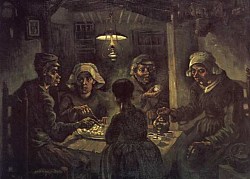
Having chosen art as his new profession van Gogh went to Brussels (October 1880- April
1881), where he studied anatomical and perspective drawing at the Academy of Art. In
January 1882 he moved to The Hague and settled there not far from his cousin, the artist
Mauve, whom he admired and who became his teacher. With Mauve van Gogh for the first time
tried oils. Accordingly, his early painting of August 1882 Beach with Figures and Sea with
a Ship is strongly influenced by The Hague School to which Mauve belonged. During
1883-1885 van Gogh traveled and worked in The Hague, Nueven, where his parents' new home
was, Amsterdam. His models were poor people, slums, hard working peasants; he painted
landscapes and town views, all in dark, somber colors.
March 26, 1885 his father died. Vincent was heart-broken. In this mood he painted The
Potato-Eaters, the main work of his Dutch period. In January 1886 he entered the Ecole des
Beaux-Arts in Antwerp, but already in March he left it and arrived in Paris. He started
studies in Cormon studio, the owner of which, the painter Fernand Cormon, was a fairly
unknown artist, but a quite successful teacher. Van Gogh studied in the studio for 3
months. Here he made friends with Toulouse-Latrec and Emile Bernard. Theo introduced him
to Monet, Renoir, Sisley, Pissarro, Degas, Signac, Seurat, and Gauguin who came to Paris
from Pont-Aven. From now on the colors on Vincent's palette became considerably brighter;
under the influence of Impressionists his style also changed. View of Paris from
Montmartre, Paris Seen from Vincent's Room in the Rue Lepic, Terrace of the Cafè "La
Guinguuette" and others are based on a typical Impressionist interpretation.
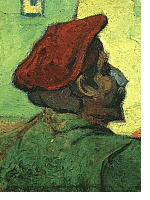 Together with Gauguin and Bernard, Van Gogh spent many days in Asnières, a
popular spa town on the Siene, not far from Paris. There he painted the views of Asnières
and the well-known The Seine with the Pont de la Grande Jatte in summer 1887. In Paris he
frequently visited the Café de Tambourin on the Boulevard de Clichy and had a love affair
with its owner Agostina Segatori, a former model of Corot and Degas. She sat for van Gogh
and he painted her many times, e.g. Agostina Segatori in the Café du Tambourin. In the
café, together with Bernard, Gauguin and Toulouse-Lautrec, he exhibited his works; they
also decorated the walls with Japanese colored woodcuts. They called themselves
"Peintres du Petit Boulevard" (painters of small boulevard) in contrast to the
"Peintres du Grand Boulevard" (Monet, Sisley, Pissarro, Degas, Seurat), who
exhibited in Theo van Gogh's gallery. That year Vincent painted several pictures using the
techniques of Pointillism, e.g. The Vase with Daisies and Anemones. During his two years
in Paris van Gogh painted more than 200 pictures. Together with Gauguin and Bernard, Van Gogh spent many days in Asnières, a
popular spa town on the Siene, not far from Paris. There he painted the views of Asnières
and the well-known The Seine with the Pont de la Grande Jatte in summer 1887. In Paris he
frequently visited the Café de Tambourin on the Boulevard de Clichy and had a love affair
with its owner Agostina Segatori, a former model of Corot and Degas. She sat for van Gogh
and he painted her many times, e.g. Agostina Segatori in the Café du Tambourin. In the
café, together with Bernard, Gauguin and Toulouse-Lautrec, he exhibited his works; they
also decorated the walls with Japanese colored woodcuts. They called themselves
"Peintres du Petit Boulevard" (painters of small boulevard) in contrast to the
"Peintres du Grand Boulevard" (Monet, Sisley, Pissarro, Degas, Seurat), who
exhibited in Theo van Gogh's gallery. That year Vincent painted several pictures using the
techniques of Pointillism, e.g. The Vase with Daisies and Anemones. During his two years
in Paris van Gogh painted more than 200 pictures.
In 1888 he left Paris and went to Arles. At first Vincent rented a room in a restaurant.
The small attic was completely unsuitable for a studio and he mainly worked out of doors.
He did not know anybody who could sit as his model, and so the landscapes of area around
Arles with its trees, hills, bridges, huts became his main theme. "An endlessly flat
landscape - seen from a bird's eye view from the top of the hill - vineyards, harvested
corn fields. All this is multiplies to infinity and spreads like the surface of the sea to
the horizon, which is bordered by the hills of Grau," wrote Vincent van Gogh about
his surroundings. He painted many pictures with blooming flowers and trees, which reminded
of Japanese landscapes. On receiving the news of Mauvre's death he dedicated a picture to
his memory Peach Tree in Bloom. Soon he moved to the "yellow house". Gradually
he made friends with people, who agreed to sit for him: Zouaves Milliet, a soldier, Joseph
Roulin, the country postman, Madame Ginoux an owner of a station restaurant in Arles, and
others.
In October, after Vincent's repeated requests, Gauguin came to stay with him in Arles. Van
Gogh was overjoyed. He gladly let Gauguin take the lead-role in art, placing himself in
the role of a student. They worked out a lot of motifs together, compared the results and
argued over artistic concepts. But their partnership could not last long, they were too
different personalities, and besides, van Gogh was seriously ill. Guaguin decided to
leave, but "ever since I wanted to leave Arles, he has been behaving so strangely
that I hardly dare to breathe. 'You want to leave', he said to me and as soon as I
answered in the affirmative he tore a piece, containing the following sentence, from the
newspaper: 'The murderer, has fled'," Gauguin was later to recall in a letter. Van
Gogh really appeared to be going mad. Gauguin waited with leave: "In spite of a few
differences I can't be angry with a good chap who is ill and suffering and calling for
me." On the 23rd of December Gauguin went for a walk in the evening and heard steps
behind, he turned and saw van Gogh, his face distorted, a razor blade in his hand. Gauguin
spoke softly to Vincent, the latter turned and went away. When later Gauguin returned
home, the whole of Arles was already there. Plagued with hallucination, Van Gogh cut off
the lower part of his left his ear; after he managed to stop bleeding he wrapped the ear
in a handkerchief, ran to the town brothel and gave the awful package to a prostitute.
Then he returned home and slept. In this state police found him and took to town hospital.
Gauguin immediately left. In order to quiet his bad conscience he later wrote in his
autobiography that van Gogh had threatened him.
Theo immediately came to Arles. Epilepsy, dipsomania and schizophrenia were the presumed
causes of Vincent's illness. He stayed in hospital for two weeks. Back in his studio he
painted the result of the catastrophe: his Self-Portrait with Bandaged Ear. Sleeplessness
and hallucinations went on. The scared citizens of Arles initiated a petition asking to
take Vincent back into hospital. Looked after by a priest and a doctor, he lived in the
Arles hospital both as patient and prisoner until the beginning of May 1889. In May,
although he felt better, he went on his own desire into the mental hospital
Saint-Paul-de-Mausole near Saint-Rémy-de-Provence. "I am ready to play the role of a
madman, although I have not at all the strength for such a role". Theo paid for two
rooms for Vincent, one as a studio with a view of the garden. He was allowed to paint
outdoors under the supervision of the ward attendant Poulet. In the hospital he painted
mainly landscapes. On January 31, 1890 Theo's son was born and baptized Vincent Willem
after his uncle and godfather. Van Gogh dedicated the Branches of an Almond Tree in
Blossom to his nephew.
In May 1890 Vincent visited Theo and his family in Paris and then settled in
Auvers-sur-Oise, near Paris. The town was chosen because Dr. Gachet, himself a hobby
painter and friend of the Impressionists, was living there, he agreed to take care of
Vincent. In Auvers van Gogh painted more than 80 pictures. During these last weeks of his
life it was only due to his work that he could forget about his illness, and he painted as
if possessed. Among the works of the period are religious works after Delacroix, Pietà
and Good Samaritan, the masterpiece The Church in Auvers, multiple landscapes and
portraits.
On the evening of the 27th July 1890 van Gogh went at dusk into the fields and shot
himself in the chest with a revolver. With all his strength he managed to drag himself
back to the inn; here he died two days later in the arms of his brother, who had hurried
to his side. Besides Theo and Dr. Gachet some friends from Paris, amongst them Bernard and
"Père" Tanguy, took part in the funeral.
Thus ended the singular life of an artist who defies comparison with any other. "I
can't change the fact that my paintings don't sell. But the time will come when people
will recognize that they are worth more than the value of the paints used in the
picture." -- Vincent van Gogh
|
|